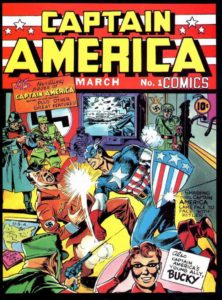 True Believers: Kirby 100th — Captain America #1 — Creators: Jack Kirby, Joe Simon and Stan Lee
True Believers: Kirby 100th — Captain America #1 — Creators: Jack Kirby, Joe Simon and Stan Lee
True Believers: Kirby 100th — Eternals #1 — Writer/Pencils: Jack Kirby; Inks: John Verpoorten; Colors: Glynis Wein
Generations: Wolverine and All-New Wolverine #1 — Writer: Tom Taylor; Art: Ramon Rosanas; Colors: Nolan Woodard
The Ultimates² #100 — Writer: Al Ewing; Art: 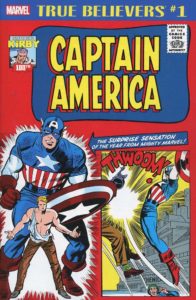 Travel Foreman, Filipé Andrade, Marco Lorenzana and Scott Hanna; Colors: Dan Brown with Matt Yachey
Travel Foreman, Filipé Andrade, Marco Lorenzana and Scott Hanna; Colors: Dan Brown with Matt Yachey
Silver Surfer #13 — Writer: Dan Slott; Art: Michael Allred; Colors: Laura Allred
Some Marvel first and (almost) last issues: at the low low price of $1, Captain America #1 is the most historically interesting, since it reprints the cover and eight-page Joe Simon/Jack Kirby origin (plus another seven-page story) from 1941, along with his ten-page 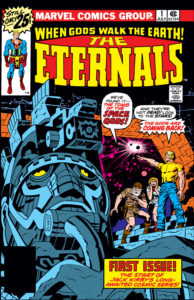 1965 origin in Tales of Suspense #63. Really good stuff, although I wish the book’s cover had reprinted the 1941 debut instead of the Tales of Suspense one: if we’ve ever had a week when we needed to see WWII vet Jack Kirby’s iconic image of Cap punching Hitler in the face…. The other Kirby 100th anniversary book is Eternals #1, from his late-’70s return to Marvel; it felt like watered-down DC Fourth-World stuff at the time, but it’s aged remarkably well: that Kirby thrill of the cosmic, of the Big Concept, comes through as soon as you turn the first page and get hit by a double-sized panorama of an ancient Andean temple, and then all the Chariots of the Gods elements, especially the Celestials, just pull you right in.
1965 origin in Tales of Suspense #63. Really good stuff, although I wish the book’s cover had reprinted the 1941 debut instead of the Tales of Suspense one: if we’ve ever had a week when we needed to see WWII vet Jack Kirby’s iconic image of Cap punching Hitler in the face…. The other Kirby 100th anniversary book is Eternals #1, from his late-’70s return to Marvel; it felt like watered-down DC Fourth-World stuff at the time, but it’s aged remarkably well: that Kirby thrill of the cosmic, of the Big Concept, comes through as soon as you turn the first page and get hit by a double-sized panorama of an ancient Andean temple, and then all the Chariots of the Gods elements, especially the Celestials, just pull you right in.  Since the original issue was only seventeen pages, there’s plenty of room for editorial material, Kirby-written essays from the early letters pages, and other historical information and artifacts — something that the Captain America book, with its 26 pages of story, lacked. The one first issue with new material, Generations: Wolverine, like the other books in this series, uses unexplained time travel to team up the current All-New Wolverine x-23 version with her father, the early-’80s best-there-is-at-
Since the original issue was only seventeen pages, there’s plenty of room for editorial material, Kirby-written essays from the early letters pages, and other historical information and artifacts — something that the Captain America book, with its 26 pages of story, lacked. The one first issue with new material, Generations: Wolverine, like the other books in this series, uses unexplained time travel to team up the current All-New Wolverine x-23 version with her father, the early-’80s best-there-is-at- what-I-do original, in Japan with his lover Akiko, and they bond and fight ninjas and run into Sabertooth; it’s not a game-changer, but it’s well-built and has a couple of good emotional beats and should satisfy fans of both the ’80s-Claremont and the current iterations of the character. Moving from beginnings to endings, Ultimates² #100 concludes the last two Al Ewing-authored volumes of that series in its own sweeping cosmic fashion; out of all the new books this week, it most embodies Kirby’s bold go-for-it energy, with Galactus and other entities battling with the title team to unchain Eternity and save the universe, while the
what-I-do original, in Japan with his lover Akiko, and they bond and fight ninjas and run into Sabertooth; it’s not a game-changer, but it’s well-built and has a couple of good emotional beats and should satisfy fans of both the ’80s-Claremont and the current iterations of the character. Moving from beginnings to endings, Ultimates² #100 concludes the last two Al Ewing-authored volumes of that series in its own sweeping cosmic fashion; out of all the new books this week, it most embodies Kirby’s bold go-for-it energy, with Galactus and other entities battling with the title team to unchain Eternity and save the universe, while the 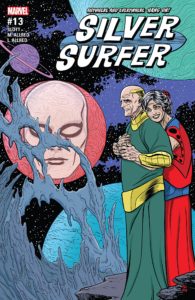 Ultimate Universe Hulk, Iron Man and Captain America guest-star (and get roundly beaten by the current team), and there’s even a small but crucial Secret Empire tie-in. Ewing’s skilled enough to make this all look effortless, and the art keeps pace; he’s got a generous essay page at the end where he thanks everyone, and the book’s various artists get a lot of well-deserved praise. Silver Surfer doesn’t conclude until next issue, but this one gives its characters a cleverly-constructed happy ending; it’s heartfelt and, in the end, sad, and Slott knows just when to back off the words and let Allred’s art carry it. If you’re a sucker for those wordless first five minutes of Up, you’ll like this too.
Ultimate Universe Hulk, Iron Man and Captain America guest-star (and get roundly beaten by the current team), and there’s even a small but crucial Secret Empire tie-in. Ewing’s skilled enough to make this all look effortless, and the art keeps pace; he’s got a generous essay page at the end where he thanks everyone, and the book’s various artists get a lot of well-deserved praise. Silver Surfer doesn’t conclude until next issue, but this one gives its characters a cleverly-constructed happy ending; it’s heartfelt and, in the end, sad, and Slott knows just when to back off the words and let Allred’s art carry it. If you’re a sucker for those wordless first five minutes of Up, you’ll like this too.
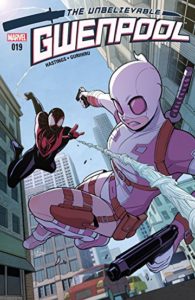 The Unbelievable Gwenpool #19 — Writer: Christopher Hastings; Art/Colors: Gurihiru
The Unbelievable Gwenpool #19 — Writer: Christopher Hastings; Art/Colors: Gurihiru
Spider-Men II #2 (of 5) — Writer: Brian Michael Bendis; Art: Sara Pichelli; Ink Assist: Elisabetta D’Amico; Colors: Justin Ponsor
Invincible Iron Man #10 — Writer: Brian Michael Bendis; Art: Stefano Caselli; Colors: Marte Gracia with Israel Silva
The Mighty Thor #22 — Writer: Jason Aaron; Art: Valerio Schiti; Colors: Veronica Gandini and Rain Beredo
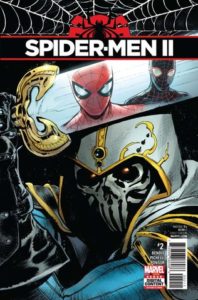 Astonishing X-Men #2 — Writer: Charles Soule; Art: Mike Deodato Jr.; Colors: Frank Martin
Astonishing X-Men #2 — Writer: Charles Soule; Art: Mike Deodato Jr.; Colors: Frank Martin
Gwenpool continues its unexpected resurgence, with its title character (“heroine” might be pushing it) coping with near-omnipotent powers that come with both a steep learning curve and an evil future version of herself; Hastings and Gurihiru have been together on this book long enough to make it a cool, clear and very smooth reading experience. No Marvel week is complete without one or two Brian Michael Bendis books: Spider-Men II, the sequel to the earlier Peter Parker/Miles Morales team-up (more of a big deal when they lived in separate, supposedly-untouchable  universes), feels like 20% of a larger work, and not a full story by itself, but the Sara Pichelli art, and the usual mysteries and sub-plots, carry it along. Invincible Iron Man feels more heartfelt (Bendis having a daughter near the age of the fifteen-year-old main character probably helps), as Riri’s refusal to just punch the terrorist villain in the head and walk away has clever repercussions. The cover probably should have gone with the next issue instead of this one, but otherwise the art is just as clear and attractive as in Spider-Men (Caselli and Pichelli: Bendis must attract skilled Italian collaborators…), and this continues to be one of the better legacy-character titles. The Mighty
universes), feels like 20% of a larger work, and not a full story by itself, but the Sara Pichelli art, and the usual mysteries and sub-plots, carry it along. Invincible Iron Man feels more heartfelt (Bendis having a daughter near the age of the fifteen-year-old main character probably helps), as Riri’s refusal to just punch the terrorist villain in the head and walk away has clever repercussions. The cover probably should have gone with the next issue instead of this one, but otherwise the art is just as clear and attractive as in Spider-Men (Caselli and Pichelli: Bendis must attract skilled Italian collaborators…), and this continues to be one of the better legacy-character titles. The Mighty 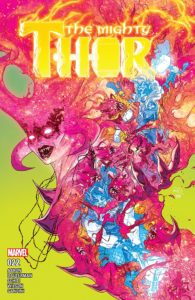 Thor, of course, has been the best, and Jason Aaron’s heady roller-coaster ride of a story, with war in the realms and at least three different Thors in play, is concluding in just two months. This installment, focusing on Muspelheim, the world of fire demons, has striking art from Valerio Schiti (enhanced by some expert coloring on all those flaming antagonists) and the usual well-played characterization, along with a lot of punching and hammering and the promise of more to come. Aaron’s shown in the past that he can stick the landing on his long-running stories, and this sprawling saga with a frail, dying woman at its core should be no
Thor, of course, has been the best, and Jason Aaron’s heady roller-coaster ride of a story, with war in the realms and at least three different Thors in play, is concluding in just two months. This installment, focusing on Muspelheim, the world of fire demons, has striking art from Valerio Schiti (enhanced by some expert coloring on all those flaming antagonists) and the usual well-played characterization, along with a lot of punching and hammering and the promise of more to come. Aaron’s shown in the past that he can stick the landing on his long-running stories, and this sprawling saga with a frail, dying woman at its core should be no  exception. Astonishing X-Men, like the other relaunched X-titles, takes much of its inspiration from the late ’80s/early ’90s versions of the team, with Rogue, Gambit, Psylocke, Angel and the newer versions of Jean Grey and Wolverine up against the Shadow King, who’s playing a world-dominating, psychic game of chess with what may or may not be the spirit form of Charles Xavier. Charles Soule catches the spirit of those earlier stories without merely copying them, and is helped by the detailed, heroic art by Mike Deodato, whose shadowy, dimly-lit panels work well in the dreamlike astral-plane setting. Old-school mutant fans should find a lot to like here.
exception. Astonishing X-Men, like the other relaunched X-titles, takes much of its inspiration from the late ’80s/early ’90s versions of the team, with Rogue, Gambit, Psylocke, Angel and the newer versions of Jean Grey and Wolverine up against the Shadow King, who’s playing a world-dominating, psychic game of chess with what may or may not be the spirit form of Charles Xavier. Charles Soule catches the spirit of those earlier stories without merely copying them, and is helped by the detailed, heroic art by Mike Deodato, whose shadowy, dimly-lit panels work well in the dreamlike astral-plane setting. Old-school mutant fans should find a lot to like here.
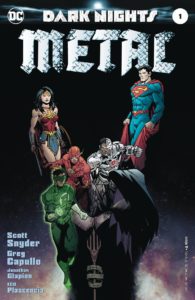 Dark Nights: Metal #1 (of 6) — Writer: Scott Snyder; Pencils: Greg Capullo; Inks: Jonathan Glapion; Colors: FCO Plascencia
Dark Nights: Metal #1 (of 6) — Writer: Scott Snyder; Pencils: Greg Capullo; Inks: Jonathan Glapion; Colors: FCO Plascencia
The Sandman Special #1 (of 1) — Creators: Various
Future Quest Presents: Space Ghost #1 — Writer: Jeff Parker; Art/Colors: Ariel Olivetti
Batman #29 — Writer: Tom King; Pencils: Mikel Janin; Inks: Hugo Petrus and Mikel Janin; Colors: June Chung
Cave Carson Has a Cybernetic Eye #11 — Writer: Jon Rivera with Gerard Way; Art: Michael Avon Oeming; Colors: Nick Filardi
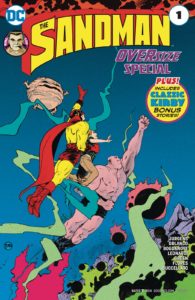 Astro City #46 — Writer: Kurt Busiek; Art: Brent Anderson; Colors: Peter Pantazis
Astro City #46 — Writer: Kurt Busiek; Art: Brent Anderson; Colors: Peter Pantazis
Dark Nights: Metal shouldn’t really work — do we really need another six-month-long comics-universe-shaking story, complete with tie-ins and one-shots, that changes what we know and introduces a bunch of new characters and concepts? Well, if the central characters are Batman and the Justice League, and if the creative team is Scott Snyder (who’s been dropping hints and laying background in his Batman tales about it for the last five years) and a popular superhero artist like Greg Capullo, then… sure: bring it on. This begins where lesser series would have ended, with what feels like the conclusion of a multi-part Justice League-vs.-Mongul story, and mixes in a  giant-robot resolution, Blackhawk Island, the Challengers of the Unknown, dinosaurs, Hawkman’s legacy, the looming menace of a vast dark-matter dimension, and a startling last-page guest star; Snyder’s as good as Geoff Johns at knowing exactly when to give fans what they want and when to swerve in unexpected directions, and this ought to be a hit.. The Sandman Special is DC’s Kirby tribute for the week; although there isn’t that much actual Kirby in it (five two-page DNAliens Jimmy Olsen backups, which have nothing to do with the title character), his influence is all over the two main stories, one by Dan Jurgens and Jon Bogdanove, and the other by Steve Orlando, Rick Leonardi and Dan Green, which feature the Kirby/Joe Simon gonzo-’70s version of the lord of the dream dimension. The tributes are touching, the
giant-robot resolution, Blackhawk Island, the Challengers of the Unknown, dinosaurs, Hawkman’s legacy, the looming menace of a vast dark-matter dimension, and a startling last-page guest star; Snyder’s as good as Geoff Johns at knowing exactly when to give fans what they want and when to swerve in unexpected directions, and this ought to be a hit.. The Sandman Special is DC’s Kirby tribute for the week; although there isn’t that much actual Kirby in it (five two-page DNAliens Jimmy Olsen backups, which have nothing to do with the title character), his influence is all over the two main stories, one by Dan Jurgens and Jon Bogdanove, and the other by Steve Orlando, Rick Leonardi and Dan Green, which feature the Kirby/Joe Simon gonzo-’70s version of the lord of the dream dimension. The tributes are touching, the 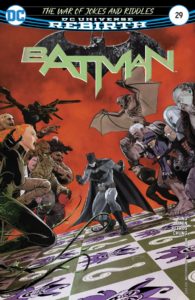 Paul Pope cover is good-looking, and even minor work from the King is worth a look — but if you only have a few dollars to spend, make sure to get those Marvel Captain America and Eternals $1 books first; they’re both cheaper and more essential. Future Quest Presents knows exactly which of its Hanna-Barbara action-animation properties is most popular; that’s why the cover logo makes it look like the book’s title is Space Ghost, and why a pinup of that character and his supporting cast are featured so prominently (on the inside, he teams up with the Herculoids, but there’s no cover love for that crew). Jeff Parker is a hack in the complimentary sense of the word — he’s good at taking longstanding commercial properties like this, Flash Gordon, etc., distilling them to their best-working elements, and then constructing a decent and satisfying, if unspectacular, story around them. Here, he has the good luck to be
Paul Pope cover is good-looking, and even minor work from the King is worth a look — but if you only have a few dollars to spend, make sure to get those Marvel Captain America and Eternals $1 books first; they’re both cheaper and more essential. Future Quest Presents knows exactly which of its Hanna-Barbara action-animation properties is most popular; that’s why the cover logo makes it look like the book’s title is Space Ghost, and why a pinup of that character and his supporting cast are featured so prominently (on the inside, he teams up with the Herculoids, but there’s no cover love for that crew). Jeff Parker is a hack in the complimentary sense of the word — he’s good at taking longstanding commercial properties like this, Flash Gordon, etc., distilling them to their best-working elements, and then constructing a decent and satisfying, if unspectacular, story around them. Here, he has the good luck to be 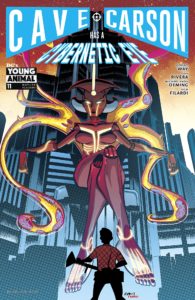 paired with Ariel Olivetti, whose painterly style and bright coloring make the panels look like animation cels, and the result is eye-catching and sleek, a Saturday-morning cartoon with enough sophistication to entertain older readers, too. Of the ongoing titles, Batman continues its Joker/Riddler war, as Bruce Wayne invites the two principles, and their villainous crews, to his mansion for a formal dinner and a proposition: he’ll give a billion dollars to whichever side convinces him they should win. Tom King, who loves using lists as a narrative device, uses the nine courses of a traditional French dinner to good effect here; Mikel Janin does a good job on all of the principles, but I particularly like his perpetually-frowning, tightly-wound, quietly-murderous Joker. Cave Carson finally explains that whole “cybernetic eye” thing (it involves alternate-dimension versions of Doc Magnus and Cave himself… as these things do), and keeps adding bizarre, pyrotechnic
paired with Ariel Olivetti, whose painterly style and bright coloring make the panels look like animation cels, and the result is eye-catching and sleek, a Saturday-morning cartoon with enough sophistication to entertain older readers, too. Of the ongoing titles, Batman continues its Joker/Riddler war, as Bruce Wayne invites the two principles, and their villainous crews, to his mansion for a formal dinner and a proposition: he’ll give a billion dollars to whichever side convinces him they should win. Tom King, who loves using lists as a narrative device, uses the nine courses of a traditional French dinner to good effect here; Mikel Janin does a good job on all of the principles, but I particularly like his perpetually-frowning, tightly-wound, quietly-murderous Joker. Cave Carson finally explains that whole “cybernetic eye” thing (it involves alternate-dimension versions of Doc Magnus and Cave himself… as these things do), and keeps adding bizarre, pyrotechnic 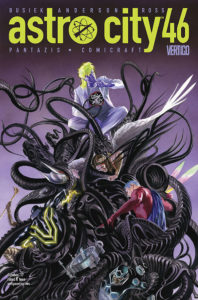 elements to the mix, including a pair of disturbingly-phallic monsters; Michael Avon Oeming handles all it with his peculiar, casually-stylish skill. That leaves Astro City, which, after 46 issues, finally gives an origin of sorts to that crazy purple guy from issue #1 who can see the readers, and wants to enlist us in fighting an omnipresent, multiverse-threatening monster; it all ties into this arc’s spirit-of-music plot (because Kurt Busiek is one of those writers where all the pieces fit carefully together, just so), and ends, if not with an actual conclusion, at least with a satisfying stopping point — the best you can hope for from an ongoing periodical comic, after all.
elements to the mix, including a pair of disturbingly-phallic monsters; Michael Avon Oeming handles all it with his peculiar, casually-stylish skill. That leaves Astro City, which, after 46 issues, finally gives an origin of sorts to that crazy purple guy from issue #1 who can see the readers, and wants to enlist us in fighting an omnipresent, multiverse-threatening monster; it all ties into this arc’s spirit-of-music plot (because Kurt Busiek is one of those writers where all the pieces fit carefully together, just so), and ends, if not with an actual conclusion, at least with a satisfying stopping point — the best you can hope for from an ongoing periodical comic, after all.
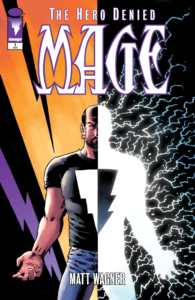 Mage: The Hero Denied #1 (of 15) — Writer/Artist: Matt Wagner; Colors: Brennan Wagner
Mage: The Hero Denied #1 (of 15) — Writer/Artist: Matt Wagner; Colors: Brennan Wagner
Sheena Queen of the Jungle #1 — Writers: Marguerite Bennett and Christina Trujillo; Art: Moritat; Colors: Andre Szymanowicz
Spy Seal #1 — Creator: Rich Tommaso
While the start of the third volume of Matt Wagner’s Mage trilogy may not be the most hotly anticipated book this week (that would be Dark Nights: Metal), it’s certainly the one that’s been anticipated the longest: Wagner published the original Mage #1 in 1984, before both Watchmen and Dark Night Returns. As this newest installment begins, we see an older Kevin Matchstick, married with children, who’s playing a mostly-defensive  game against the regrown forces of darkness; his personal life is focused and full, but his heroic one is rudderless and empty. How this will play out is anyone’s guess, especially given this volume’s subtitle, but Wagner’s narrative and artistic powers now, almost 35 years after he started this story, should make it worth reading. Sheena, Queen of the Jungle is a 25-cent introductory issue to the newest attempt to revive that Golden Age franchise. Given that it could have been one of those juvenile masterbatory books like Jungle Fantasy, it’s a pleasant surprise: Bennett and Trujillo offer an interesting take on the character (her speech patterns and education level are a lot like early Tarzan, and she feels a similar responsibility to protect her rain-forest home), and Moritat’s art is sexy and good-looking without being exploitive or cringe-worthy (although I’d love to know
game against the regrown forces of darkness; his personal life is focused and full, but his heroic one is rudderless and empty. How this will play out is anyone’s guess, especially given this volume’s subtitle, but Wagner’s narrative and artistic powers now, almost 35 years after he started this story, should make it worth reading. Sheena, Queen of the Jungle is a 25-cent introductory issue to the newest attempt to revive that Golden Age franchise. Given that it could have been one of those juvenile masterbatory books like Jungle Fantasy, it’s a pleasant surprise: Bennett and Trujillo offer an interesting take on the character (her speech patterns and education level are a lot like early Tarzan, and she feels a similar responsibility to protect her rain-forest home), and Moritat’s art is sexy and good-looking without being exploitive or cringe-worthy (although I’d love to know  where she finds perfectly-applied eye makeup in the remote Amazon basin…); for a quarter, there’s no reason not to buy it. Spy Seal is the newest from Rich Tommaso (She-Wolf, Dark Corridor, Satchel Paige). It’s got a much more European feel than the loose, almost-woodcut bluntness of She-Wolf, with anthropomorphic characters in a cool, geometric Hergé/Tintin/ligne claire style that looks like it should be on sale in a train-station newsstand in Belgium. The plot involves an Englishman (er, seal…) who’s accidentally tangled up in an assassination attempt, and then gets recruited by British intelligence to find some mysterious Maguffin-y artifact; if you like that genre, this is a very accomplished example of it.
where she finds perfectly-applied eye makeup in the remote Amazon basin…); for a quarter, there’s no reason not to buy it. Spy Seal is the newest from Rich Tommaso (She-Wolf, Dark Corridor, Satchel Paige). It’s got a much more European feel than the loose, almost-woodcut bluntness of She-Wolf, with anthropomorphic characters in a cool, geometric Hergé/Tintin/ligne claire style that looks like it should be on sale in a train-station newsstand in Belgium. The plot involves an Englishman (er, seal…) who’s accidentally tangled up in an assassination attempt, and then gets recruited by British intelligence to find some mysterious Maguffin-y artifact; if you like that genre, this is a very accomplished example of it.
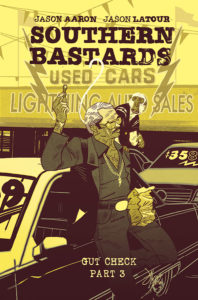 Southern Bastards #17 — Writer: Jason Aaron; Art/Colors: Jason Latour
Southern Bastards #17 — Writer: Jason Aaron; Art/Colors: Jason Latour
Rick and Morty: Pocket Like You Stole It #2 (of 5) — Writer: Tini Howard; Art: Marc Ellerby; Colors: Katy Farina
Motor Girl #8 — Creator: Terry Moore
I Hate Fairyland #15 — Writer/Artist: Skottie Young; Colors: Jean-Francois Beaulieu
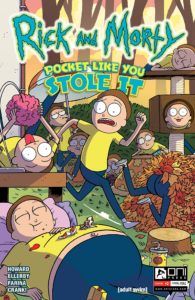 Southern Bastards returns after a longish hiatus (artist Jason Latour’s father died, and there’s a touching tribute to him on the editorial/letters pages), still in the middle of its latest Southern-Gothic arc, as Coach Boss, embroiled in a violent game of one-upmanship with a rival high school and its football team, sees both his private and professional lives crumbling; you’ll probably have to dig out the last couple of issues to remember what’s going on, but it’s just as cornpone-noir good as always. So too for Rick and Morty‘s current mini-series, offering a Pokémon
Southern Bastards returns after a longish hiatus (artist Jason Latour’s father died, and there’s a touching tribute to him on the editorial/letters pages), still in the middle of its latest Southern-Gothic arc, as Coach Boss, embroiled in a violent game of one-upmanship with a rival high school and its football team, sees both his private and professional lives crumbling; you’ll probably have to dig out the last couple of issues to remember what’s going on, but it’s just as cornpone-noir good as always. So too for Rick and Morty‘s current mini-series, offering a Pokémon 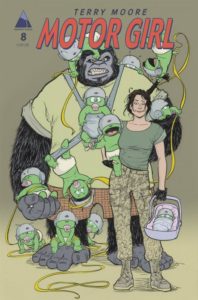 satire involving multiple interdimensional Ricks trying to catch and fight-train multiple interdimensional Mortys; if you’ve never tried this before, a stand-alone issue of the regular comic might be a better bet, but if you’re a fan of the darkly-anarchic humor of the TV cartoon already, then you should like this, too. Motor Girl is Terry Moore’s latest ongoing series; after Strangers in Paradise, Echo and Rachel Rising, he’s an automatic buy, and this tale about a damaged Iraqi War vet with a brain tumor, a
satire involving multiple interdimensional Ricks trying to catch and fight-train multiple interdimensional Mortys; if you’ve never tried this before, a stand-alone issue of the regular comic might be a better bet, but if you’re a fan of the darkly-anarchic humor of the TV cartoon already, then you should like this, too. Motor Girl is Terry Moore’s latest ongoing series; after Strangers in Paradise, Echo and Rachel Rising, he’s an automatic buy, and this tale about a damaged Iraqi War vet with a brain tumor, a 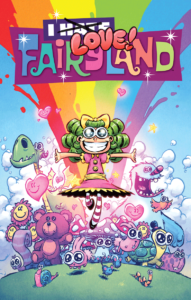 hallucinatory gorilla friend, and actual space aliens hanging around the junkyard where she works has the same combination of slapstick humor, drama and imagination as all his other stuff. With I Hate Fairyland, you either get Skottie Young’s gleefully-sophomoric send-up of kids’-lit fantasy conventions, or you don’t; if you do, the “Good Gert” version of the main character here is scarier than her normal, more-murderous one, and the cliffhanger ending shows that, although the book’s Gilligan’s Island premise will get old eventually, we’re not there yet.
hallucinatory gorilla friend, and actual space aliens hanging around the junkyard where she works has the same combination of slapstick humor, drama and imagination as all his other stuff. With I Hate Fairyland, you either get Skottie Young’s gleefully-sophomoric send-up of kids’-lit fantasy conventions, or you don’t; if you do, the “Good Gert” version of the main character here is scarier than her normal, more-murderous one, and the cliffhanger ending shows that, although the book’s Gilligan’s Island premise will get old eventually, we’re not there yet.



